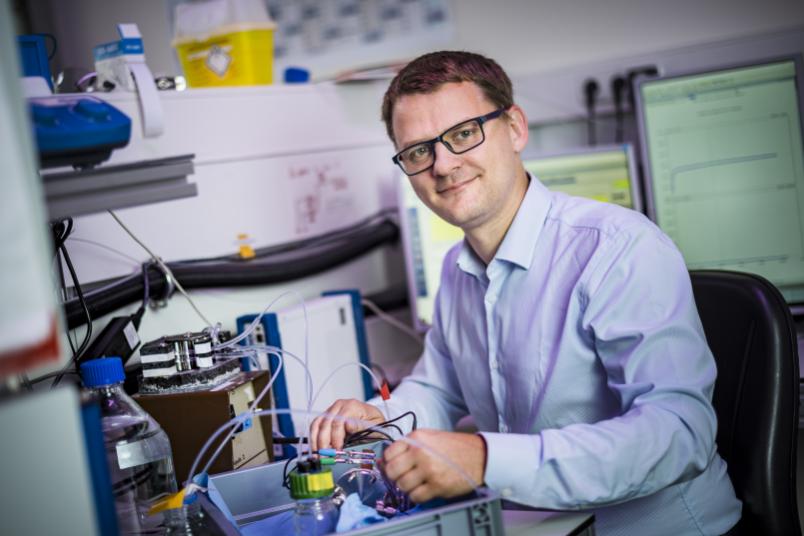
Interview
Ways through the Valley of Death
Closing the gap between basic and applied research is one of Ulf-Peter Apfel's goals.
Climate protection measures are at the heart of the United Nations’ Sustainable Development Goal number 13. Specifically, this involves both a reduction of CO2 emissions and a reduction in the use of fossil raw materials. Professor Ulf-Peter Apfel and his groups contribute significantly to achieving this sustainability goal: At the Faculty of Chemistry and Biochemistry as well as the Electrosynthesis Department of the Fraunhofer Institute for Environmental, Safety and Energy Technology UMSICHT, they are researching the production of green hydrogen and the question of how carbon dioxide can be turned into starting materials for the chemical industry.
Professor Apfel, what does your work involve?
We deal with electrolysis technologies. Electrolysis is a chemical process in which a redox reaction takes place through electricity – preferably green electricity. The focus is on the splitting of a chemical compound, for example of water into hydrogen and oxygen. Electrolysis can also be used to convert the unavoidable CO2 that is produced in e.g. the steel and cement industries into basic chemicals or fuels.

We want to overcome this valley of death with our research.
Are these technologies already in use?
As climate protection becomes more important and the energy and raw materials transition takes place, electrolysis technologies are of course increasingly in the spotlight. However, there is currently still a large gap between basic research and industry. In other words, there are plenty of catalyst candidates and concepts for electrodes and cells, but unfortunately most of them are not ready for the market. We want to overcome this valley of death with our research.
But what causes this gap?
For one thing, communication between the various interest groups is far from optimal. For another, basic research usually doesn’t take into account the conditions under which the electrolysis must function in industry: will the system developed in the lab remain stable in the long term? Are the starting materials available in sufficient quantities? And is the amount of energy required at all justifiable from a financial and environmental point of view? To give you a specific example: in the laboratory, electrolysis works best with clean water to produce hydrogen. At some industrial sites, however, that is precisely what is in short supply.
What are you doing to close this gap?
We are looking, for example, at how electrolysis might work with polluted water. However, the main focus of our research at the moment is on identifying low-cost and widely available catalysts. Electrolysis usually involves the use of catalysts containing precious metals. These are of course expensive, limited in supply and therefore not a good option for industry.
In addition, we are tackling the problem of scalability. In the lab, we develop catalysts in the kilogram range and electrodes up to a maximum size of one square metre, while our prototypes fit in a container. That is, of course, much too small for industry. Industrial hydrogen production, for example, has completely different dimensions. There are plants in operation there that fill entire halls.

This kind of cooperation also means that I, as a professor, take a back seat more often.
What does the actual research activity in your group look like?
We work in interdisciplinary teams in our projects. This is because it is often crucial to draw on the expertise of different specialists from the fields of chemistry, engineering and also economics and social sciences. That’s the only way we can approach our research holistically without neglecting important aspects. Sometimes projects can fail because of social acceptance: a hydrogen filling station is a fine thing, but if the people around it only see it as a potential bomb, it will never be a success. What is needed here is education and not just technological development. However, this kind of cooperation also means that I, as a professor, take a back seat more often: I provide the right framework conditions so that my team can do a good job.
For whom could your research be of interest?
In addition to companies in the hydrogen production sector, it could be large companies that are looking for new concepts that can be automated. When it comes to CO2 reduction, it’s also operators of special plants – for example, cement plants. There, CO2 continues to be emitted as waste gas. However, this is becoming more and more expensive in view of CO2 certificates. It would be cheaper to use the CO2 as a raw material for other chemical products and to sell these products on.
What kind of products could these be?
These include, for example, higher alcohols or olefins from which polymers can be manufactured. But also food supplements or medicines.